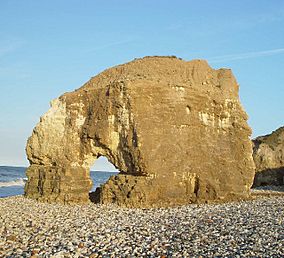Durham Coast facts for kids
Quick facts for kids Durham Coast |
|
|---|---|

Blackhall Rocks on the Durham coast
|
|
| Location | Hartlepool, County Durham, Tyne and Wear, North East, England |
| Area | 765.41 ha (1,891.4 acres) |
| Established | 1960 |
| Governing body | Natural England |
| Website | Map of site |
The Durham Coast is a very special natural area in County Durham, England. It's known as a Site of Special Scientific Interest (SSSI) because of its unique plants, animals, and geology. This amazing coastline stretches from just south of Crimdon Dene near Hartlepool all the way north to the mouth of the River Tyne at South Shields. Along the way, you'll find interesting spots like Seaham, Sunderland Docks, and Whitburn Beach.
Contents
A Coast Shaped by Time
Amazing Rocks and Cliffs
The Durham Coast is super important for studying rocks and how landforms change over time. It includes six special places that are part of the Geological Conservation Review. One of these is Marsden Bay, which scientists have been studying since the 1950s.
The cliffs and beaches here are made of a type of rock called dolomite and limestone. These rocks formed a very long time ago, during the late Permian period. If you look closely at the sea cliffs between Trow Point and Whitburn Bay, you can see clues about how sea levels have changed over thousands of years!
Home to Unique Nature
Special Plants
The Durham Coast is famous for its incredible variety of plants. It has most of the unique "paramaritime Magnesian Limestone vegetation" found in Britain. This means the plants growing here are special because they live near the sea on a specific type of limestone rock. This plant life is different from other grasslands in Durham.
Different parts of the coast have different plants:
- In the open, heathland areas, you might see plants like red fescue, sea plantain, and thrift.
- In more sheltered spots, the grassy areas have many beautiful flowering plants. These include the pyramidal orchid and rare plants like marsh helleborine, grass-of-Parnassus, round-leaved wintergreen, and bird’s-eye primrose.
- Even the sand dunes and golf courses have their own special mix of plants. In some wet, low-lying areas within the dunes, you can find marsh orchids and common twayblade.
Wonderful Wildlife
The Durham Coast is also a great place for animals, especially birds and insects.
- Many birds visit or live here, including important groups of sanderling and purple sandpiper (which spend their winters here). You might also spot little terns breeding along the coast.
- The area is home to a rich variety of invertebrates, which are animals without backbones, like insects. This includes special butterflies like the Durham Argus (Aricia artaxerxes salmacis) and a small moth called the least minor moth (Photedes captiuncula).

